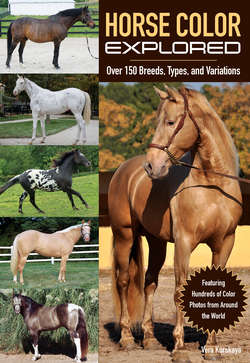Читать книгу Horse Economics - Vera Kurskaya - Страница 41
Other Colors Determined by Silver
ОглавлениеThe Silver gene dilutes only areas of hair containing eumelanin, and so it has no effect on red hair. The term silver chestnut is occasionally used in English writings on the subject of horse color to describe horses with a chestnut base that are carriers of the Silver gene. Such horses have the potential of producing silver offspring.
If the Silver gene is present in a horse in combination with other dilution genes, the resulting colors can become difficult to identify when only observing the phenotype. This is especially difficult in the Rocky Mountain Horse, Mountain Pleasure Horse, and the Icelandic Horse breeds, in which many individuals have similar combinations of genes. For example, the mane and tail hair diluted by the Silver gene can be mixed up with frosting, a characteristic of dun colors (see p. 22). In combination with the dun or buckskin, the effect of the Silver gene shows very poorly. For example, a silver dun horse looks very similar to a bay dun but also has pale yellow or whitish guard hair; however, the legs are dark, sometimes with leg webbing. I was lucky enough to discover this color in Byelorussian Harness Horses. The silver buckskin also looks quite ambiguous. The color ranges from sandy to whitish, and the mane and tail are diluted brown or dirty yellow. This color is found in Icelandic Horses, where some time ago it was mistaken for the Champagne dilution (see p. 32). One more rare combination is silver grullo. This horse is externally very similar to grullo—the only difference is an almost-white mane and tail, and sometimes leg webbing.
Silver smoky black determined by the Silver gene plus one Cream Dilution gene appears, on the outside, to be very similar to ordinary silver black with a little more yellowish or brownish shade to the body (Photos 61 & 62). Unfortunately, it isn’t always possible to measure this difference by the eye.
There are additional rare combinations, such as silver dun buckskin, which can occur in the Icelandic breed. The horse is a light, sandy color, the lower part of the legs is light ashy, and sandy-colored hair is mixed with black and ashy in the mane and tail. Primitive markings are brown.
